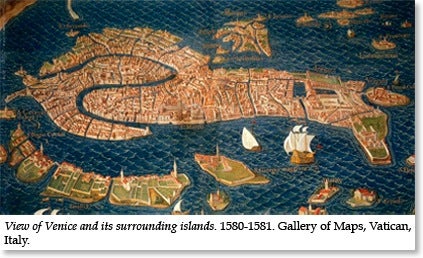
Much like the modern metropolises of New York City, Paris, London, and Beijing, Venice thrived as one of the leading cosmopolitan centers of the sixteenth century. As a result of its strategic placement between East and West, the many immigrant and merchant populations that converged upon Venice’s shores heavily influenced the social and cultural dynamics of the island Republic. The diverse, enlightened and uncommonly tolerant society that resulted from these influences can be explored in order to testify the city’s role as a catalyst for progress, innovation, and the cultivation of greater intellectual freedom and opportunity for both women and men of the sixteenth century.
Venice’s political and mercantile ambitions resulted in the development of an expansive maritime empire, populated by a wealthy merchant class educated in foreign commerce and trade. As one of the few city-states to retain its independence during the sixteenth century, Venice was able to expand its territory across the Alps, Northeastern Europe, the Adriatic Sea, and Dalmatia to the Mediterranean islands of Corfu, Crete and Cyprus. Venice’s strategic location between East and West further promoted its growth as a center for commerce and trade. The resultant rise of a diverse merchant class cultivated an environment that promoted the exchange of goods and the rise of education in many foreign markets. This cosmopolitan atmosphere led to a surge in both social and cultural freedom; foreigners were not condemned, but rather welcomed into society. Dominant foreign and ethnic populations included the Dalmatians, the Jews, and the Greeks.
The intellectual life of Venice was greatly influenced by the nearby University of Padua and the development of the printing press. The university was founded in 1222 upon the objective of providing a more liberal and diversified education to its students; it was the only university that Venetian society allowed their young nobles to attend. From the fifteenth to the eighteenth century, the university was renowned for its research, particularly in the areas of medicine, astronomy, philosophy and law. Intersections and conflicts between theological beliefs and humanist perspectives were also raised to awareness and extensively explored. These ideas circulated throughout society, and can be attributed to greatly enriching and broadening Venetian thought. Furthermore, the presence of publisher Aldus Manutius (1450-1515) enabled the development of the Venetian printing press in 1469. By 1500, Venice had already established itself as a major world publisher and both male and female writers were allowed to publish. The development of Greek and Italic fonts, as well as the production of octavos increased the affordability of these productions and aided in their wide dispersal. The Classics as well as Reform ideals were printed in Venice, thereby attributing to the invigoration of enlightenment and educational values.
An informal academic “salon” provided another unique avenue for intellectual cultivation, especially for women. While women were still strictly forbidden to attend universities, some women (generally courtesans) were granted restricted access to the poetic discussions, concerts, and debates that took place within these salons. Veronica Franco, among several other leading women of the sixteenth century, used the salon as her own means to gain access into the literary world and ultimately to let her voice be heard.
In this section, you will find a timeline relating sixteenth century Europe to the life of Franco, a discussion of women’s role in the family, public world, and literary and artistic milieu, and a summary of the fashions of Venetian courtesans.
Timeline
Women in 16th Century Italy
Venetian Women Writers
Fashions of the Venetian Courtesans
© 2013 – 2023 Veronica Franco (Archived)